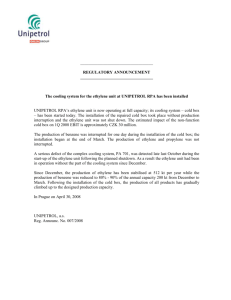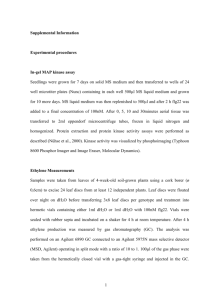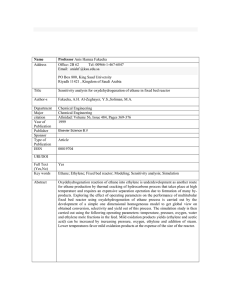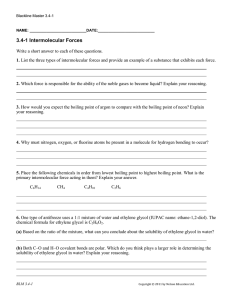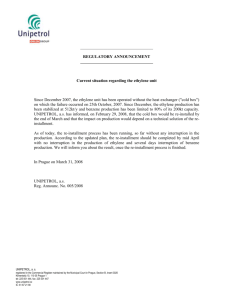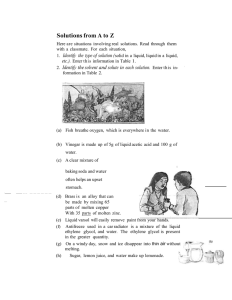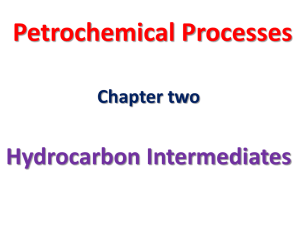Ethylene hydrocarbon, consisting of four hydrogen atoms and two carbon
advertisement
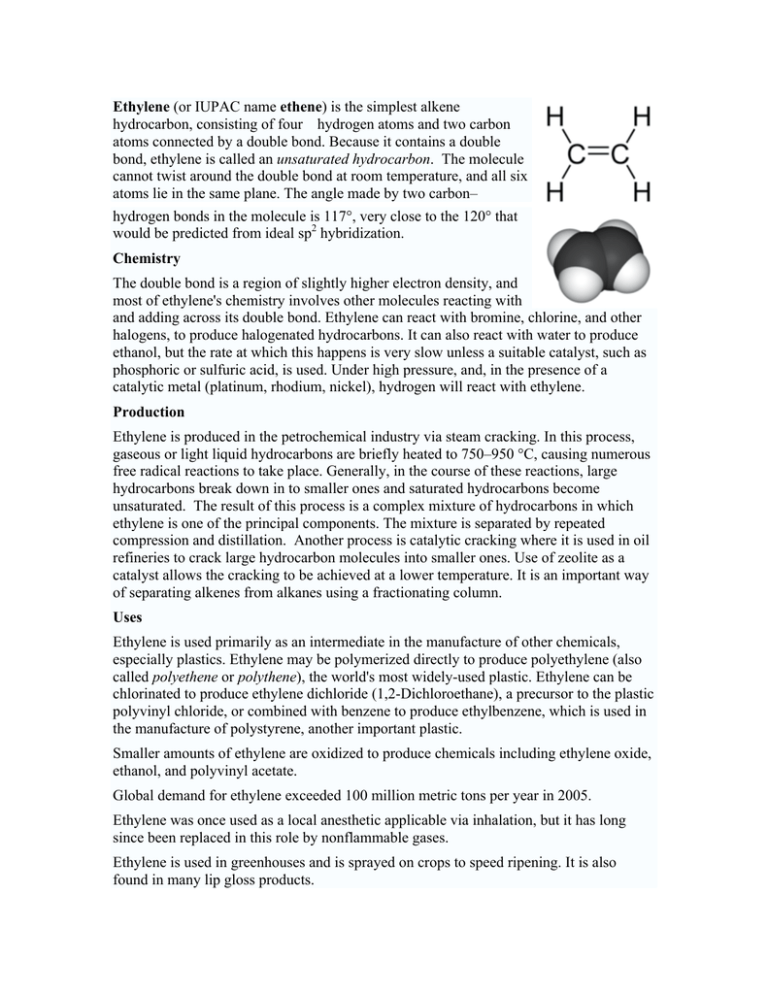
Ethylene (or IUPAC name ethene) is the simplest alkene hydrocarbon, consisting of four hydrogen atoms and two carbon atoms connected by a double bond. Because it contains a double bond, ethylene is called an unsaturated hydrocarbon. The molecule cannot twist around the double bond at room temperature, and all six atoms lie in the same plane. The angle made by two carbon– hydrogen bonds in the molecule is 117°, very close to the 120° that would be predicted from ideal sp2 hybridization. Chemistry The double bond is a region of slightly higher electron density, and most of ethylene's chemistry involves other molecules reacting with and adding across its double bond. Ethylene can react with bromine, chlorine, and other halogens, to produce halogenated hydrocarbons. It can also react with water to produce ethanol, but the rate at which this happens is very slow unless a suitable catalyst, such as phosphoric or sulfuric acid, is used. Under high pressure, and, in the presence of a catalytic metal (platinum, rhodium, nickel), hydrogen will react with ethylene. Production Ethylene is produced in the petrochemical industry via steam cracking. In this process, gaseous or light liquid hydrocarbons are briefly heated to 750–950 °C, causing numerous free radical reactions to take place. Generally, in the course of these reactions, large hydrocarbons break down in to smaller ones and saturated hydrocarbons become unsaturated. The result of this process is a complex mixture of hydrocarbons in which ethylene is one of the principal components. The mixture is separated by repeated compression and distillation. Another process is catalytic cracking where it is used in oil refineries to crack large hydrocarbon molecules into smaller ones. Use of zeolite as a catalyst allows the cracking to be achieved at a lower temperature. It is an important way of separating alkenes from alkanes using a fractionating column. Uses Ethylene is used primarily as an intermediate in the manufacture of other chemicals, especially plastics. Ethylene may be polymerized directly to produce polyethylene (also called polyethene or polythene), the world's most widely-used plastic. Ethylene can be chlorinated to produce ethylene dichloride (1,2-Dichloroethane), a precursor to the plastic polyvinyl chloride, or combined with benzene to produce ethylbenzene, which is used in the manufacture of polystyrene, another important plastic. Smaller amounts of ethylene are oxidized to produce chemicals including ethylene oxide, ethanol, and polyvinyl acetate. Global demand for ethylene exceeded 100 million metric tons per year in 2005. Ethylene was once used as a local anesthetic applicable via inhalation, but it has long since been replaced in this role by nonflammable gases. Ethylene is used in greenhouses and is sprayed on crops to speed ripening. It is also found in many lip gloss products. Impact of Katrina Katrina took 10% of U.S. ethylene production capacity off-line. Industry experts don’t expect a return to “normal” capacities until the end of the year. Chemical Market Associates, Inc. (CMAI) projects a 1.9% growth in U.S. ethylene demand in 2006 vs. 2005, while capacity is only expected to expand by 0.3%. Banc of America Securities expects global ethylene supply to remain constrained through 2008. Meanwhile, SRI Consulting projects 4 to 5% per year growth in world ethylene demand from 2005 to 2009, slowing to 3 to 4% from 2009 to 2014. This will require the construction of 3 or 4 world class ethylene crackers per year to maintain supply. The number of cracker projects currently slated for construction is not enough to meet the projected demand growth. Some more info…. Ethylene US Production: 28.70 x 106 tons per year Worldwide Production: 84.16 x 106 tons/year Price: $0.495 per pound Growth rate: +5.1% (estimated) Ethylene is an extremely important molecule as indicated by the enormous worldwide production rate of 84 x 106 tons per year. The US accounts for about 28% of that total. Ethylene is important because of the various products that can be made from it. Ethylene is used commercially as the primary feed for manufacturing polyethylene, ethylene dichloride, ethylbenzene, ethylene oxide, ethanol, EPDM rubber, and vinyl acetate, as well as other commercially important chemicals. Each of these products, in turn, is expected to increase in use from 5-10% per year over then next five years. Thermal cracking of hydrocarbons is the principal route for the industrial production of ethylene. Thermal cracking is the process whereby hydrocarbon molecules spontaneously breakdown at high temperatures, usually above 100 °C. However, temperatures in excess of 500 °C are usually required to achieve reasonable reaction rates. In thermal cracking, valuable by-products including propylene, butadiene, and benzene are also produced. Commercially less valuable methane and fuel oil are also produced in significant proportions. An important parameter in the design of commercial thermal cracking furnaces is the selectivity to produce the desired products. The thermal cracking of hydrocarbons proceeds via a free-radical mechanism [1]. Since that discovery, many reaction schemes have been proposed for various hydrocarbon feeds [2-5]. Since radicals are neutral species with a short life, their concentrations under reaction conditions are extremely small. Therefore, the integration of rate equations involving radical and molecular species requires special integration algorithms [6]. An approximate method known as pseudo steady-state approximation has been used in chemical kinetics for many years, which originally came from the study of alkane cracking reactions [7-8]. Thermal cracking of hydrocarbons is accomplished in tubular reactors commonly known as plug-flow reactors (PFRs). These reactors are also commonly referred to as cracking furnaces, crackers, and cracking heaters. Several engineering contractors including ABB Lummus Global, Stone and Webster, Kellogg-Brown & Root, Linde, and KTI offer cracking furnace technology. Usually two cracking furnaces share a common stack, and the height of the heater may vary from 30 to 50 m. Before the 1960s, the cracking tubes were arranged in horizontal rows in a radiant chamber leading to low ethylene capacity. Modern designs use tubes arranged in vertical rows, providing superior mechanical performance and higher capacity. The capacity of a single furnace is well over 130,000 t/yr. A typical sketch of such a furnace is shown below. In the figure above, BFW=boiler feed water, SSH=superhigh pressure steam, HP=high pressure, and ID=induced draft. The reaction proceeds in the pyrolysis coils of the radiant section of the furnace. Since coke is also formed during pyrolysis, steam is added as a diluent to the feed. The steam minimizes the side reaction forming coke, and improves selectivity to produce the desired olefins by lowering hydrocarbon partial pressure. The temperature of the hydrocarbon and steam mixture entering the radiant chamber (known as the crossover temperature) is 500 to 700°C. Lower temperatures are used for heavy feeds like atmospheric gas oil (AGO) and vacuum gas oils (VGO), and higher temperatures are used for light gases like ethane and propane. Some cracking can start as low as 400°C. However, for light gases incipient conversion is quite low. Depending on the residence time and required feed severity, the coil outlet temperature is typically maintained between 775 and 950°C. Chemical engineers have developed many ways to make this method more efficient. These methods involve use of distillation towers to separate the products, and novel reaction schemes to convert byproducts into ethylene. All of these processes are profitable because the products are considerably more valuable than the reactants. High profit margins will continue to drive growth in the ethylene economy for the foreseeable future. References 1. F. O. Rice, J. Am. Chem. Soc. 53, 1959 (1931);. 2. K. M. Sundaram and G. F. Froment, Ind. Eng. Chem. Fund. 17, 174 (1978). 3. D. L. Allara and D. A. Edelson, Int. J. Chem. Kinet. 7, 479 (1975). 4. D. L. Allara and R. A. Shaw, J. Phys. Chem. Ref. Data 9, 523 (1980). 5. M. Dente and E. Ranzi, in L. F. Albright, B. L. Crynes, and W. H. Corcoran, eds., Pyrolysis Theory and Industrial Practice, Academic Press, Inc., New York, 1983. 6. C. W. Gear, Numerical Initial Value Problems in Ordinary Differential Equations, Prentice-Hall, Inc., Englewood Cliffs, N.J., 1971. 7. C. W. Gear, Numerical Initial Value Problems in Ordinary Differential Equations, Prentice-Hall, Inc., Englewood Cliffs, N.J., 1971. 8. M. Boudart, Kinetics of Chemical Processes, Prentice-Hall, Inc., Englewood Cliffs, N.J., 1968.
